The Motor Omnibus Boom.
Page 5
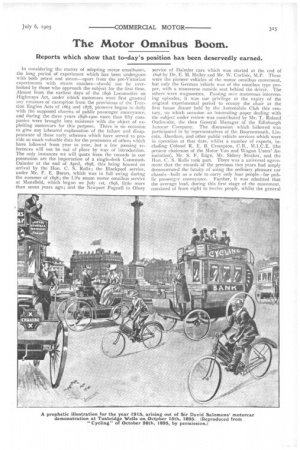
Page 6

Page 7
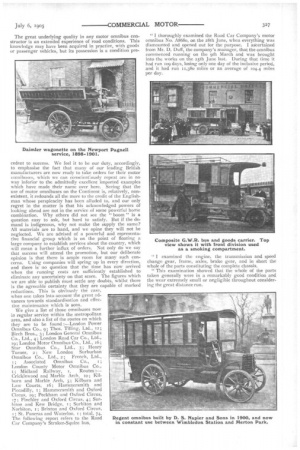
Page 8
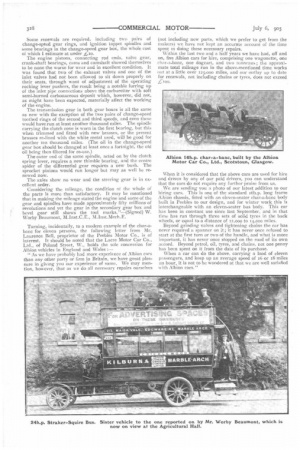
Page 10
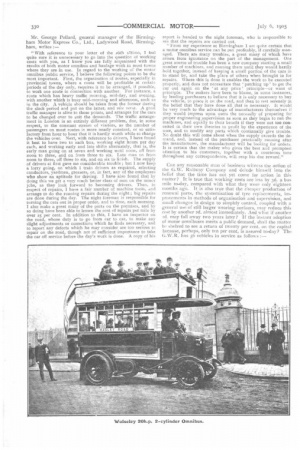
Page 11
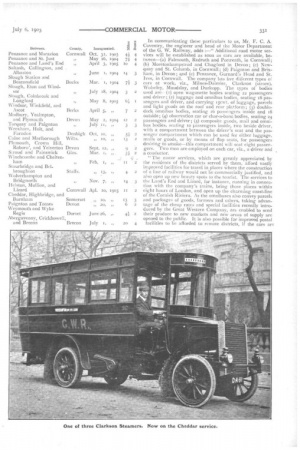
Page 12
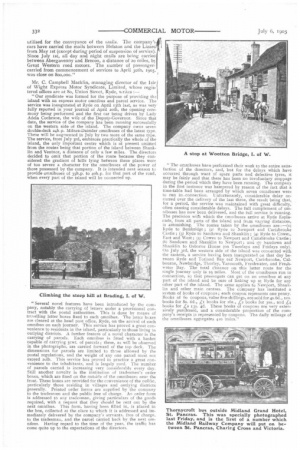
Page 13
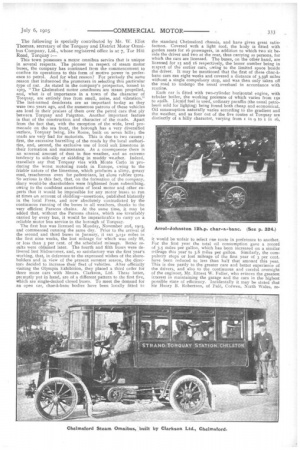
Page 14
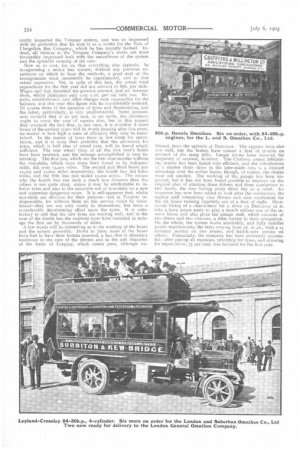
Page 18

If you've noticed an error in this article please click here to report it so we can fix it.
Reports which show that to-day's position has been deservedly earned.
In considering the matter of adopting motor omnibuses, the long period of experiment which has been undergone with both petrol and steam—apart from the pre-Victorian experiments with steam coaches—should not be overlooked by those who approach the subject for the first time. Almost from the earliest days of the 1896 Locomotive on Highways Act, under which motorcars were first granted any measure of exemption from the provisions of the Traction Engine Acts of 1865 and 1878, pioneers began to daily with the supposed charms of public passenger conveyance, and during the three years 1898-1900 more than fifty companies were brought into existence with the object of exploiting motorcars for this purpose. There is no occasion to give any laboured explanation of the failure and disappearance of these early schemes which have served to provide so much valuable data for the promoters of others which have followed from year to year, but a few passing references will not be out of place by way of introduction. The only instances we will quote from the records in our possession are the importation of a single-deck CannstattDaimler at the end of April, 1898, this being housed on arrival by the Hon. C. S. Rolls; the Blackpool service, under Mr. F. E. Baron, which was in full swing during the summer of 1898; the Lifu steam motor omnibus service at Mansfield, which began on July ist, 1898, little more than seven years ago; and the Newport Pagnell to Olney service of Daimler cars Which was started :It the end of 180 by Dr. E. M. Hailey and Mr. W. Carlisle, M.P. These were the pioneer vehicles of the motor omnibus movement, but only the German vehicle was of the omnibus type proper, with a transverse outside seat behind the driver. The others were wagonettes. Passing over numerous intervening episodes, it was our privilege at the expiry of the original experimental period to occupy the chair at the first house dinner held by the Automobile Club this century, on which occasion an interesting paper dealing with the subject under review was contributed by Mr. T. Roland Outhwaite, the then General Manager of the Edinburgh Autocar Company. The discussion which followed was participated in by representatives of the Bournemouth, Lincoln, Aberdare, and other public vehicle services which were in operation at that date, whilst a number of experts, including Colonel R. E. B. Crompton, C.B., M.1.C.E. (the present chairman of the Motor Van and Wagon Users' Association), Mr. S. F. Edge, Mr. Sidney Straker, and the Hon. C. S. Rolls took part. There was a universal agreement that the records of the previous two years had amply demonstrated the fatuity of using the ordinary pleasure car chassis—built as a rule to carry only four people—for public passenger conveyance. Further, it was admitted that the average load, during this first stage of the movement, consisted of from eight to twelve people, whilst the general practice was to trust to Providence that the mechanism and frame would stand. The result, needless to say, invariably was that the engine, gearing, bearings, chains and all working parts proved much too light for the work imposed upon them. In addition, the frames not infrequently sagged badly. The repairs mounted up so heavily, after the first few months, that it became practically impossible to keep the machines going on a paying basis. Again, in these early days, the driver difficulty was acute, suitable men simply being unobtainable, except after long and tedious training. There were so many parts of the ear which required constant attention, especially the ignition, that it was very difficult indeed to avoid repeated delays on the road. Combustion of the mixed charge in the cylinders was any. thing but perfect, partly owing to the inferiority of the ignition, which was almost invariably of the heated platinum tube type, and partly to that of the petroleum spirit, with resulting valve troubles which also caused disruption of the services. The conclusion of the whole discussion was, in fact, that success could not attend the use of public ser. vice vehicles larger than those weighing about 3ocwt. un laden and carrying fourteen passengers. The two large double-deck petrol omnibuses which were put on the streets in the year 1900 by the London Steam Omnibus Company, Ltd., to which company Mr. Sidney Straker was consulting engineer, and which ran upon solid iron tyres, yielded sufficiently discouraging results to confirm that view, which has since been so completely upset. At that date, however, the limiting factor was largely a question of tyres, because rubber of a suitable nature, to say nothing about a proper means of attachment to the rims, was not then obtainable as it is to-day. Engineers had to deal with the materials available to their hands, and to keep the vehicles on the road was little short of a superhuman task. Success was possible only where the management was irreproachable— which was seldom the case with so many gaining their experience—and where, concurrently, the fares obtainable were usually unremunerative.
The second stage of progress in this country dates back to the third Liverpooi Trials held in the year 1901. For the first time in the history of these competitions, the internal combustion system of generating power was represented. Two lorries, declared for a load of 3oewt. each, and fitted with two-cylinder petrol engines giving about e.eb.h.p., were entered by G. F. Milnes and Co., Ltd., of Birkenhead and Hadley. At this time Mr. Frederick R. Simms was managing director and consulting engineer to Messrs. Mu!nes' motor vehicle department, of which Mr. H. G. Burford, the present managing director of Milnes-Daimler, Limited, was sales manager. The first successful modern motor omnibus was a practical counterpart, granting improvements in detail, of these two lorries, which secured the highest award of the L.S.P.T.A. in this connection there is no disgrace in allowing that nobody at that time clearly foresaw the rapid developments that were to ensue, neither can anybody grudge Mr. Burford the great success which has rewarded his pertinacity and application over the problem of evolving his double-deck omnibuses to the use of which these pages testify. At the same time, other makers have not been idle. Whilst it is a pleasure to see those who have worked hardest in one direction gain the first fruits of their labours, it is impossible for any one maker to stand alone in an industry such as the one we are considering. We do not hesitate to say that there can be no best machine; but there can be, and are, several of equal an-round excellence to those of foreizn build which first made The great underlying quality in any motor omnibus constructor is an extended experience of road conditions. This knowledge may have been acquired in practice, with goods or passenger vehicles, but its possession is a condition pre cedent to success. We feel it to be our duty, accordingly, to emphasise the fact that many of our leading British manufacturers are now ready to take orders for their motor omnibuses, which we can conscienEously repeal are in no way inferior to the admittedly excellent imported examples which have made their name over here. Seeing that the use of motor omnibuses on the Continent is, relatively, nonexistent, it redounds all the more to the credit of the Englishman whose perspicacity has been alluded to, and our only regret in the matter is that his acknowledged powers of looking ahead are not in the service of some powerful home combination. Why others did not see the " boom " is a question easy to ask, but hard to satisfy. But if the demand is indigenous, why not make the supply the same? All materials are to hand, and we opine they will not be neglected. We are advised of a powerful and representative financial group which is on the point of floating a large company to establish services about the country, which will mean a further influx of orders. Not only do we say that success will attend the promotion, but our deliberate opinion is that there is ample room for many such concerns. Using companies will spring up in every direction, and there is no question that the time has now arrived when the running costs are sufficiently established to eliminate any uncertainty on that score. The figures which we are able to publish must settle any doubts, whilst there is the agreeable certainty that they are capable of marked reductions. This is obviously the case, when one takes into account the great advances towards standardisation and effective maintenance which is seen.
We give a list of those omnibuses now in regular service within the metropolitan area, and also a list of the routes on which they are to be found :—London Power Omnibus Co., 9; Thos. Tilling, Ltd., 12; Birch Bros., 3; London General Omnibus Co., Ltd., 4; London Road Car Co., Ltd., 19; London Motor Omnibus Co., Ltd., 16; Star Omnibus Co., Ltd., 3; Henry Turner, 2; New London Surburban Omnibus Co., Ltd., 2; French, Ltd., 1; Associated Omnibus Co.,
London County Motor Omnibus Co.,
; Midland Railway, I. Routes :— Cricklewood and Marble Arch, lo; Kilburn and Marble Arch, 3; Kilburn and Law Courts, 16; Hamtnersmith and Piccadilly, 1; Hammersmith and Oxford Circus, 19; Peckham and Oxford Circus, 17; Finchley and Oxford Circus, 4; Surhiton and Kew Bridge, I: Surbiton and Norbiton, I; Brixton and Oxford Circus, ; St. Pancras and Waterloo. I; total, 74. The following report refers to the Road Car Company's Straker-Squire bus. "I thoroughly examined the Road Car Company's motor omnibus No. A868o, on the 28th June, when everything was dismounted and opened out for the purpose. I ascertained from Mr. D. Duff, the company's manager, that the omnibus commenced running on the 9th March and was brought into the works on the 25th June last. During that time it had run 109 days, losing only one day of the inclusive period, and it had run 11,380 miles or an average of 104.4 miles per day.
"I examined the engine, the transmission and speed change gear, frame, axles, brake gear, and in short the whole of the parts constituting the complete chassis.
"This examination showed that the whole of the parts taken generally were in a remarkably good condition and the wear extremely small or negligible throughout considering the great distance run.
Some renewals are required, including two pairs of change-speed gear rings, and ignition tappet spindles and some bearings in the change-speed gear box, the whole cost of which I estimate at under k,to.
The engine pistons, connecting rod ends, valve gear, crank-shaft bearings, cams and camshaft showed themselves to be none the worse for wear and in excellent condition. It was found that two of the exhaust valves and one of the inlet valves had not been allowed to sit down properly on their seats, through want of adjustment of the operating rocking lever pushers, the result being a notable furring up of the inlet pipe connections above the carburetter with soft semi-burned carbonaceous deposit which, however, did not, as might have been expected, materially affect the working of the engine.
The transmission gear in both gear boxes is all the same as new with the exception of the two pairs of change-speed toothed rings of the second and third speeds, and even these would have run at least another thousand miles. The spindle carrying the clutch cone is worn in the first bearing, hut this when trimmed and fitted with new brasses, or the present brasses re-lined with the white metal used, will be good for another ten thousand miles. (The oil in the change-speed gear box should be changed at least once a fortnight, the old oil being then filtered for re-use.) The outer end of the same spindle, acted on by Lhe clutch spring lever, requires a new thimble bearing, and the centre spider of the differential gear requires a new bush. The sprocket pinions would run longer but may as well be renewed now.
The axles show no wear and the steering gear is in excellent order.
Considering the mileage, the condition of the whole of the parts is more than satisfactory. It may be mentioned that in making the mileage stated the engine and some of the gear and spindles have made approximately fifty millions of revolutions and vet the gear in the secondary gear box and bevel gear still shows the tool marks."—(Signed) W. Worby Beaumont, M. I nst. C. E., M. Inst. Mech. F.
Turning, incidentally, to a modern example of the char-abane for eleven persons, the following letter from Mr. Laurence Bell, proprietor of the Peebles Motor Co., is of interest. It should be noted that the Lacre Motor Car Co.. Ltd., of Poland Street, W., holds the sole concession for Albion vehicles in England and Wales :— " As we have probably had more experience of Albion cars than any other party or firm in Britain, we have great pleasure in giving you our experience of same. We may mention, however, that as we do all necessary repairs ourselves (not including new parts, which we prefer to get from the makers) we have not kept an accurate account of the time spent in doing these necessary repairs. Within the last two and a half years we have had, off and on, five Albion cars for hire, comprising one wagonette, one char-a-bane, one dogcart, and two tcnneaus; the approximate total mileage run in the above-mentioned time works out at a little over 125,000 miles, and our outlay up to date for renewals, not including chains or tyres, does not exceed L:too.
When it is considered that the above cars are used for hire and driven by any of our paid drivers, you can understand that the cars do not require any further praise from us. We are sending von a photo of our latest addition to our hiring cars. This is one of the standard ibh.p. long frame Aibion chassis, fitted with an eleven-seater char-a-bane body built in Peebles to our design, and for winter work this is interchangeable with an eleven-seater bus body. This car has been in constant use since last September, and in that time has run through three sets of solid tyres in the back wheels, or equal to a distance of 12,000 .10 14,000 miles.
Beyond grinding valves and tightening chains the car has never required a spanner on it ; it has never once refused to start at the first turn or two of the handle, and what is more important, it has never once stopped on the road of its own accord. Beyond petrol, oil, tyres, and chains, not one penny has been spent on it from the date of its purchase.
When a car can do the above, carrying a load of eleven passengers, and keep up an average speed of 16 or 18. miles an hour, it is not to be wondered at that we are well satisfied with Albion cars."
Mr. George Pollard, general manager of the Birmingham Motor Express Co., Ltd., Ladywood Road, 13irmingham, writes :
"With reference to your letter of the 26th ultimo, I feel quite sure it is unnecessary to go into the question of working costs with you, as I know you are fully acquainted with the results of both motor omnibus and haulage work in most towns where they are in use. In regard to the working of the motor omnibus public service, I believe the following points to be the most important. First, the organisation of routes, especially in provincial towns, where a route will be profitable at certain periods of the day only, requires it to be arranged, if possible, to work one route in connection with another. For instance, a route which has heavy traffic morning, mid-day, and evening, with another which is busy mid-morning and afternoon, such as in the city. A vehicle should be taken from the former during the slack period and put on the latter, and vies versa. A good traffic manager is alive to these points, and arranges for the cars to be changed over to suit the demands. The traffic arrangement in London is an entirely different problem, due, in some respect, to the constant stream of visitors, as the number of passengers on most routes is more nearly constant, Or SO Satisfactory from hour to hour that it is hardly worth while to change the vehicles over. Next, with reference to drivers, I have found it best to have two to each bus, working eight hours per day each, and working early and late shifts alternately, that is, the early man going on at seven and working until noon, off from noon to three, and on from three to six. Late man on from noon to three, off three to six, and on six to finish, The supply of drivers at first gave me considerable trouble ; but I now keep a lorry going, on which I train drivers as required, selecting conductors, yardmen, greasers, or, in fact, any of the employees who show an aptitude for driving. I have also found that by doing this we get a very much better class of men on the minor jcbs, as they look forward to becoming drivers. Then, in respect of repairs, I have a fair number of machine tools, and arrange to do the running repairs during the night ; big repairs are done during the day. The night foreman is responsible for turning the cars out in proper order, and to time, each morning. I also make a great many of the parts on the premises, and by so doing have been able to lessen the cost of repairs per mile by over 25 per cent. In addition to this, I have an inspector on the road, whose duty is to go from car to car, to make any slight adjustments or corrections which he finds necessary, and to report any defects which he may consider are too serious to repair on the road, though not of sufficient importance to take the car off service before the day's work is done. A copy of his report is handed to the night foreman, who is responsible to see that the repairs are carried Out.
" From my experience at Birmingham I am quite certain that a motor omnibus service can he run profitably, if carefully managed. There are many troubles, a great many of which have arisen from ignorance orc the part of the managemeet. One great source of trouble has been a new company starting a small number of machines, and running them until they would hardly held together, instead of keeping a small portion of the cars in to stand by, and take the place of others when brought in fur repairs. Where this is done it enables the work to be executed properly, and does not necessitate that 'patching up' to get the car out again on the ' at any price' principle—or want of principle. The makers have been to blame, in some instances, he leading purchasers to believe that it is only necessary to buy the vehicle, to place it on the road, and then to rest serenely in the belief that they have done all that is necessary. It would be very much to the advantage of manufacturers themselves il they would impress upon users the necessfty of preparing for proper engineering supervision as soon as they begin to run the machines, and equally to their benefit if they were not too conceited in their own theories to profit by the experience of the user, arid to modify any parts which continually give trouble. No doubt this will come about when the supply exceeds the demand, and, instead of the purchaser practically running after the manufacturer, the manufacturer will be looking for orders. It is certain that the maker wile gives the best and promptest attention to his customers, together with a COUrteOus tone throughout any correspondence, will reap his clue reward."
Can any reasonable man of business witness the action of the G. \V. Railway Company and delude himself into the belief that the time has not yet come for action in this matter? It is true that working costs are less by 3d. a bus mile to-day, compared with what they were only eighteen months ago. It is also true that the cietiper production of renewal parts, the systemisation of tyre replacements, improvements in methods of organisation and supervision, and small changes in design to simplify control, coupled with a general use of still larger wearing surfaces, may reduce this cost by another ad. almost immediately. And what if another id. may fall away two years later? If the instant adoption of motor omnibuses meets a public demand, shall the matter bo shelved to see a return of twenty per rent, on the capital because, perhaps, only ton per cent, is assured to-day? The G.W.R. has Le.,6 vehicles in service as follows :—
In communicating these particulars to us, Mr. F. C. A. Coventry, the engineer and head of the Motor Department of the G. W. Railway, adds :—" Additional road motor services will be established as soon as cars are available, between—(a) Falmouth, Redruth and Portreath, in Cornwall; (b) Moretonhampstcad and Chagford in Devon; (c) Newquay and St. Colutnb, in Cornwall; (d) Paig.nton and Brix ham, in Devon; and (e) Penzance, Gurnares Head and St. Ives, in Cornwall. The company has five different types of cars at work, viz., Milnes-Daimler, Clarkson (steam), Wolseley, Maudslay, and Durkopp. The types of bodies used are(7) open wagonette bodies seating 22 passengers and driver ; (2) luggage and omnibus bodies, seating 18 passengers and driver, and carrying iscwt. of luggage, parcels and light goods on the roof and rear platform ; (3) doubledeck omnibus bodies, seating 16 passengers inside and 18 outside; (4) observation car or char-a-bane bodies, seating 24 passengers and driver ; (5) composite goods, mail and omnibus bodies, seating io passengers inside, two beside driver, with a compartment between the driver's seat and the passenger compartment which can be used for either luggage. mails or goods, or by means of flap scats, for passengers desiring to smoke—this compartment will scat eight passengcrs. Two men are employed on each car, viz., a driver and a conductor.
"The Motor services, which are greatly appreciated by the residents of the districts served by them, afford vastly
improved facilities for travel in places where the construction of a line of railway would not be commercially justified, and also open up new beauty spots to the tourist. The services to the Land's End and Lizard, for instance, running in connection with the company's trains, bring those places within eight hours of London, and open up the charming coast-line of the Cornish Riviera. As the omnibuses also convey parcels and packages of goods, farmers and others, taking advantage of the cheap rates and special facilities recently introduced by the Great Western Company, are enabled to send their produce to new markets and new areas of supply are opened to the public. It is also possible for improved postal facilities to be afforded to remote districts, if the cars are utilised for the conveyance of the mails. The company': cars have carried the mails between Helston and the Lizard from May ist (except during period of suspension of service). Since July ist, all day and night mails are being carrier: between Abergavenny and Brecon, a distance of zo miles, by Great Western road motors. The number of passenger: carried from commencement of services to April 3oth, tgos, was close on 800,000."
Mr. C. Campbell Macklin, managing director of the Isle' of Wight Express Motor Syndicate, Limited, whose registered offices are at 8o, Union Street, Ryde, u rites :—
"Our syndicate was formed for the purpose of providing the island with an express motor omnibus and parcel service. The service was inaugurated at Ryde on April i3th last, as was very fully reported in your journal of April 20th, the opening ceremony being performed and the first car being driven by Lady Adele Cochrane, the wife of the Deputy-Governor. Since that date, the service of the company has been running successfully on the western side of the island. The company owns seven double-deck 24h.p.lnes-Daimler omnibuses of the latest type. These will be augmented in July by two more of the same type. The service, from July 3rd, embraces practically the whole of the island, the only important centre which is at present omitted from the routes being that portion of the island between Shank. lin and Ventnor, a distance of only a few miles. The directors decided to omit that portion of the route because they considered the gradient of hills lying between the places were of too severe a character for the omnibuses of the power of those possessed by the company. It is intended next season to provide omnibuses of 35h.p. to 4oh.p. for that part of the road, when every part of the island will be connected up.
"Several novel features have been introduced by the company, notably the carrying of letters under a provisional contract with the postal authorities. This is done be meens of travelling letter boxes fixed to each omnibus. The lettcr boxes are cleared at the head post office, Ryde, on the arrival of each omnibus on each journey. This service has proved a great convenience to residents in the island, particularly to those living in outlying districts. A further feature of a novel character is the carrying of parcels. Each omnibus is Stied with a basket capable of carrying scwt. of parcels ; these, as will be observed in the photographs, are carried forward of the top deck. The dimensions for parcels are limited to these allowed by the postal regulations, and the weight of any one parcel must not exceed eulb. This service has proved in practice a great convenience to the inhabitants, and is latgely used. The number of parcels carried is increasing very considerably every day. Still another novelty is the institution of tradesmen's order boxes, which are fixed on the outside of the omnibuses near the front. These boxes are provided for the convenience of the public, particularly those residing in villages and outlying districts generally. Printed order forms are supplied by the company to the tradesmen and the public free of charge. An order form is addressed to any tradesman, giving particulars of the goods required, with a request that they should be sent out by the next omnibus. This form, having been filled in, is placed. in the box, collected at the place to which it is addressed and Immediately delivered by the company's servants, free of charge, to the tradesman, and the parcel carried back by the neet omnibus. Having regard to the time of the year, the traffic has come quite up to the expectations of the directors. " The omnibuses have performed their work to the entire satisfaction of the directors, and, but for the delays which have occurred through want of spare parts and defective tyres, it may be fairly said that there has been no involuntary stoppage during the period which they have been running. 'Die company in the first instance was hampered by reason of the fact that a tune-table had been arranged by which seven omnibuses were to run in. connection. Unfortunately, considerable delay occurred over the delivery of the last three, the result being that, for a period, the service was maintained with great difficulty, often causing considerable delays. The full complement. of omnibuses has now been delivered, and the full service is running. The precision with which the cmnibuses arrive at Ryde Esplanade, from all parts of the island and frisra varying distances, is astonishing. The routes taken by the omnibuses are :—(t) Ryde to Bembridge ; (2!. Ryde to Newport and Carisbrooke Castle ; (3) Ryde to Sandown and Shank tin; Ryde to Cowes., East and West ; (si Cowes to Newport and Carisbrooke Castle; (6) Sandown and Shauklin to Newport ; and (7) Sandown and Shanklin to Osborne House (on Tuesdays and Fridays only). (in July 3rd, the western side of the island was connected with the eastern, a service having been inaugurated on that day between Ryde and Totland Bay old Newport, Carisbrooke. Calbourne, Newbridge, Thorley, Yarmouth, Freshwater, and Freshwater Bay. The total distance on this latter route for the single journey only is te miles. Most of the omnibuses run in connection, so that passengers can get on an omnibus at any part of the island and be sure of linking up at Hyde for any other part of the island, The same applies to Newport, Shank. lin and other main centres. The company has instituted a system of books of coupons ; each coupon represents one penny. Books of 6o coupons, value five shillings, are sold for 4s.6d., books for Ss. 6d., Acr books for 16s., Le books for 305., and A books for La 135. ad. These books of coupons are very extensively purchased, and a considerable proportion of the company's receipts is represented by coupons. The daily mileage of the omnibuses aggiegates 420 miles."
The following is specially contributed by Mr. %V. Eliot Thomas, secretary of the Torquay and District Motor Omnibus Company, Ltd., whose registered office is at 7, Tor Hill Road, Torquay :— This town possesses a motor omnibus service that is unique in several respects. The pioneer in respect of steam motor buses, the company has continued from the commencement to confine its operations to this form of motive power in preference to petrol. And for what reason? For precisely the same reason that influenced the promoters in selecting this particular type of car. As stated in the company's prospectus, issued in x903, "The Chelmsford motor omnibuses are steam propelled, and, what is of importance in a town of the character of Torquay, are entirely free from smell, noise, and vibration." The last-named desiderata are as important to-day as they were two years ago, and the numerous patrons of these vehicles are loud in their praises of them over the petrol cars that ply between Torquay and Paignton. Another important feature is that of the construction and character of the roads. Apart from the fact that, with the exception of the wide, level promenade on the sea front, die borough has a very diversified surface, Torquay being, like Rome, built on seven hills; the reads are very bad for motorists. This is due to two causes ; first, the excessive barrelling of the roads by the local authorities, and, second, the exclusive use of local soft limestone in their formation and maintenance. As a consequence there is an unusual amount of dust in fine weather, and an extreme tendency to side-slip or skidding in muddy weather. Indeed, travellers say that Torquay vies with Monte Carlo in producing the worst motoring roads in Europe, owing to the friable nature of the limestone, which produces a slimy, greasy mud, treacherous even for pedestrians, let alone rubber tyres. Soserious is this fact, that, on the formation of the company, xiiany would-be shareholders were frightened from subscribing, owing to the confident assertions of local motor and other experts that it would be impossible for any motor buses to run at times on account of skidding—assertions, published blatantly in the local Press, and now absolutely contradicted by the continuous running of the buses in all weathers, thanks to the very efficient Parsons chains. At the same time, it may be added that, without the Parsons chains, which are invariably carried by every bus, it would be impracticable to carry on a reliable motor bus service in the borough of Torquay.
The first bus was licensed on Monday, November and, 1903, and commenced running the same day. Prior to the arrival of the second and third buses in January, it ran 3,032 miles in the first nine weeks, the lost mileage for which was only 88, or less than 3 per cent, of the scheduled mileage. Better results were obtained later. The fourth and fifth buses were delivered last Midsummer, and, so satisfactory was the first year's working, that, in deference to the expressed wishes of the shareholders and in view of the present summer season, the directors decided to increase their fleet of vehicles. After officially visiting the Olympia Exhibition, they placed a third order for three more cars with Messrs. Clarkson, Ltd. These latter, prcmptly put in hand, are of a different pattern to the first five, which are single-decked closed buses. To meet the demand for an open car, char-a-banc bodies have been locally fitted to the standard Chelmsford chassis, and have given great satisfaction. Covered with a light roof, the body is fitted with garden seats for 16 passengers, in addition to which two sit beside the driver and two at the rear, thus carrying /CI persons, for which the cars are licensed. The buses, on the other hand, are licensed for x5 and so respectively, the lesser number being in rospect of the earlier cars, owing to the limited space beside the driver. It may be mentioned that the first of these char-abane cars ran eight weeks and covered a distance of 3,598 miles without a single compulsory stop, and was then only taken off the road to undergo the usual overhaul in accordance with routine.
Each car is fitted with two-cylinder horizontal engine, with tubular boiler, the working pressure of which varies from eco to asolb. Liquid fuel is used, ordinary paraffin (the usual petroleum sold for ligkting) being found both cheap and economical. Oil consumption naturally varies according to the gradient and the weather, and as four out of the five routes at Torquay are distinctly of a hilly character, varying from z in 9 to x in i6,
it would be unfair to select one route in preference to another. For the first year the total oil consumption gave a record of 3.5 miles per gallon, which has been increased on a similar mileage this year to 3.8 miles per gallon. Similarly, the compulsory stops or lost mileage of the first year of 3 per cent. have been reduced to less than half that amount this year. This is due partly to the greater care and better experience of the drivers, and also to the continuous and careful oversight of the engineer, Mr. Ernest W. Fuller, who evinces the greatest interest in maintaining the garage and the cars in the -highest possible state of efficiency. Incidentally it may be stated that Sir Henry B. Robertson, of Paid, Corwen, North Wales, re
cently inspected the Torquay system, and was so impressed with its perfection that he took it as a model for the Vale of Llangollen Bus Company, which he has recently formed. Indeed, all visitcrs to the Torquay Company's works are most favourably impressed both with the smoothness of the system and the splendid running of the cars.
Now as to cost, for on that everything else depends. In inaugurating a motor bus system, without any previous experience on which to base the methods, a good deal of the arrangements must necessarily be experimental, and to that extent expensive. Yet, in spite of this fact, the actual total expenditure for the first year did not amount to Net. per mile. Wages and fuel absorbed the greatest amount, just 5d. between them, whilst lubricants only cost 0.2d. per car mile run. Repairs, establishment, and other charges were responsible for the balance, and this year this figure will be considerably reduced. Of course there is the question of tyres and depredation, and the latter, particularly, is very problematical. Some accountants contend that it 2o per cent, is set aside, the allowance ought to cover the cost of repairs also, but in this respect they overlook the fact that, in any case, it is doubtful if some buses of the earliest types will be worth running after five years, no matter in how high a state of efficiency they may be maintained. In the matter of tyres there is less room for specie. Iation, and it is more than probable that the allowance for tyres, which is half that of petrol cars, will be found amply sufficient. The rear wheel tyres of all the first year's buses have been renewed, and the mileage accemplished is very interesting. The first bus, which ran the first four months without the non-skids, which have since been found to be indispensable, did over 13,400 miles. The second and third buses ran 12,175 and 12,600 miles respectively, the fourth bus did 8,8o0 miles, and the fifth bus just under 12,000 ruile. The reason why the fourth bus ran such a much less distance than the others is not quite clear, unless it may be attributable to inferior tyres and also to the excessive use of non-skids on a new and somewhat dangerous route. It is self-apparent that, whilst non-skids are effective for their purpose—and in Torquay indispensable, for without them no bus service could be maintained—they are not only costly in themselves, hut have a ecnsiderable deteriorating effect upon the tyres. It is satisfactory to add that the new tyres are wearing well, and in the case of the fourth bus the renewed tyres have exceeded in mileage the first set by thousands of miles.
A few words will be interesting as to the working of the buses and the system generally. Down to June, none of the buses have had to have their boilers renewed, a fact that is abundant testimony to the care of the drivers and to the soft character of the water of Torquay, which comes pure, although un
filtered, from the uplands of Dartmocr. The engines have also rue well, but the brakes have caused a deal of trouble on account of the steep hills. Larger drums have lessened the frequency of renewal, however. The Clarkson patent lubricating system has been found very efficient, and the introduction of a shorter chain drive in the later-made ears is a distinct advantage over the earlier buses, though, of course, the chains wear out quicker. The working of the garage has been improved, but it has not been found passible to improve on the original plan. of allotting three drivers and three conductors to two buses, the men having every third day as a relief. An inspector has now been added to look after the conductors, the regular staff comprising nine drivers and nine conductors for the six buses running regularly out of a fleet of eight. Occasictial hiring of a char-a-bane for a drive on Dartmoor or to take a lawn tennis party to play a match utilises one of the reserve hoses and also gives the garage staff, which consists of two fitters and two cleaners, a little variety in their occupation. On the whole, the system works admirably, and fully satisffes puolic requirements, the fares varying from id. to 4d., with a 15 minutes' service on two routes, and half-h..iurly service on others. Financially, the company has been eminently successful ; after paying all expenses, providing for tyres, rind allowing for depreciation, 71 per cent, was declared for the first year. The Eastbourne Corporation figures prove that the total cost per car mile, even with a large proportion of unsuitable buses, is on'iy io.67d. Allowing for the extra depreciation which should be debited in respect of single-deck vehicles, this becomes 11.42d. per car mile, a result which is. borne out at Birmingham and elsewhere. It should be pointed out here that Eastbourne originaiiv intended to have electric .traction. Two schemes were considered. One was to cost „4.3o,000 for a route Length of 3,170 yards with seven tramcars. As that was considered too expensive, a revised estimate of L2o,000 for only 2,200 yards of route and four tramcars was considered, but this was rejected in favour of motor omnibuses early in 1902. For less than ,to,000 Eastbourne got a service of ten omnibuses over more than seven route miles, and the electrical advisers to the corporation agree that there must have been a serious oss with electric traction, to say nothing of a less convenient means of conveyance. The total working costs were no less than 14.39d. per car mile for the nine months ending December 31st, 1y03, so a material reduction has been effected already, and there is room for still further improvements when the underpowered and otherwise unsuitable port:ons of the pqant are written down Or disposed of. If LI.:owattec is made for depreciation, the Torquay steam figures are alse about tod. per car mile. It seems pretty clearly established that the more equal driving effort yielded hv a steam engine saves the tyres from rapid wear.
.1 close examination of the records in our passess:on indicates that the total cost of running an omnibus service, inclusive of depreciation at the rate of 20 per cent. per annum on the cars, repairs, fuel and lubricants, tyres, lighting and heating, rent, rates, taxes, insurance, drivers, conductors, depot staff, foremen, and general management, including directors, will not, given ordinary business control, exceed 10.5d. per car mile. If Eastbourne and Birmingham,. for example, were able to get rid of some of the earlier types of vehicles which are owned, without excessive loss on capital account which would then require to be recouped out of revenue, the results achieved prove that the cosi should not exceed io.5d, per car mile. Taking into consideration the fact that this figure is almost on a level with legitimate tramway costs, and having regard to the ability of the motor omnibus to pick up and set down by the pavement, to overtake another carrying unit which is at rest, to vary its route at yin, and its higher average speed, there is no question that lower initial capital expenditure is not the only inducement which can now fairly be put before municipal authorities and private enterprises for their most serious consideration at the present juncture of events.
" THE COMMERCIAL MOTOR " is at the disposal of any who desire to be given specific. information on specific points, and we shall be happy to afford particulars of any kind in our power, either by letter or through the medium of our correspondence columns.


























